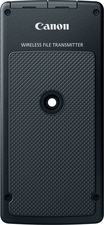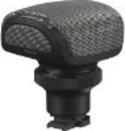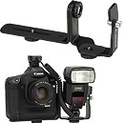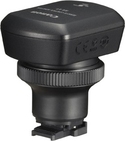The Canon WFT-E7 Wireless File Transmitter has been launched alongside the Canon EOS 5D Mark III DSLR to offer the ability to wirelessly transmit images from your camera to a computer – it gives enhanced remote capture, media server functionality, linked shooting, plus built-in Bluetooth connection functionality.
The new WFT-E7 unit takes the WiFi possibilities with the EOS 5D Mark III to new levels by offering advantages such as 802.11a/b/g and n compatibility, DLNA compliance, FTP, EOS Utility and WFT Server shooting, as well as Linked Shooting for remote shutter triggering of other WiFi-enabled EOS cameras.
Who is it for?
The WFT-E7 unit allows for the rapid transfer of images to an access point and out to a picture desk, making it great for sports and news photographers. Studio photographers will enjoy the ability to see previews of their images on a large screen by transmitting JPEGs to their computer. Some photographers will find the built-in Bluetooth compatibility useful as it allows them to use a Bluetooth connection to a GPS device for geo-tagging images. Those photographers who like experimenting with technology to push the boundaries of what is possible will find the Linked Shooting and advanced WFT Server modes especially appealing.
enlarge image
Please click here to take a tour around the WFT-E7 Wireless File Transmitter.
Key features
- IEEE 802.11a, 802.11b, 802.11g and 802.11n compatibility;
- Gigabit LAN RJ45 port;
- Linked shooting;
- Digital Living Network Alliance (DNLA) compatible;
- WFT Server shooting;
- EOS Utility Mode;
- Built-in Bluetooth transceiver;
- Wireless Time Syncing;
- WiFi Protected Setup (WPS);
- Internal antenna with range of approximately 150 metres.
The WFT-E7 transmitter offers high-speed wireless file transfer via three transmission modes for connection to other devices. FTP is used to transfer images to an FTP server. EOS Utility mode allows two-way communication between the camera and a computer (as if they were connected by a USB cable), while WFT Server mode allows a web browser to view images stored on the memory card and remote control of the camera.
The unit is a universal design that can be used with the EOS 5D Mark III and future mid-range EOS models so you can make an investment that will operate with future products. The WFT-E7 can either be mounted to the tripod socket on the bottom of the EOS 5D Mark III, or onto a dedicated bracket that is available separately.
Continuing the capability first available in Canon’s EOS 7D DSLR, the WFT-E7 offers the ability to remotely trigger other EOS 5D Mark III cameras fitted with WFT-E7 units. This means that a master camera fitted with a WFT-E7 can control up to 10 slave cameras that are also fitted with WFT-E7, WFT-E6, WFT-E2 II, WFT-E4 II or WFT-E5 units and can be triggered from the master camera from up to 100 metres away. In this way, you can capture an image of a subject from several different viewpoints at the same time. The lag between triggering the master camera and the slave cameras firing is around 0.05sec – this lag remains the same whether the master camera is positioned one metre or 100 metres from the slave cameras.
With the use of the WFT-E7’s built-in WFT Server the EOS 5D Mark III can be controlled wirelessly over an HTTP connection using a web browser. This means you can see what your camera sees and control the settings and shooting functions through a web browser (or a device like a smart phone or tablet). You can also browse and download captured images.
A new development for WFT server functions is Linkage with WFT Server. This combines the benefits of both Linked Shooting and WFT Server, so that each of the remote linked cameras can be browsed independently and have their settings changed. Equally, if the master camera is triggered over WFT Server all of the linked slave cameras will trigger as well.
To help to conserve the battery life of the EOS 5D Mark III, the WFT-E7 features a power-saving option. If ‘LAN power save’ is set to ‘Enable’ in the camera menu, the WFT-E7 will complete any remaining image transfers, log off the remote FTP server and then set itself into a sleep state. This stops the connection remaining active needlessly and wasting battery power. Powered by either an LP-E6 battery or an AC adaptor ACK-E6, it does not require many different battery types to be carried.
First seen on the WFT-E6 WiFi unit, the WFT-E7 has built-in Bluetooth functionality so that, instead of using a Bluetooth dongle with the WFT unit, the WFT-E7 unit can communicate directly with a Bluetooth GPS device to allow automatic geo-tagging of images within the EXIF data.
Unlike the EOS-1D X, the EOS 5D Mark III doesn’t feature a built-in LAN port. The WFT-E7 fulfils this function, offering all the same functionality as you have wirelessly, but uses a gigabit LAN cable connection, which is even faster than 802.11n and allows the rapid sending of RAW files if required.
WFT Server
WFT Server is an update of the previously named HTTP mode. Where HTTP allowed you to access the images on the camera and download them over an HTTP connection with a web browser, WFT Server allows full control over the camera settings, including the use of Live View Mode, so that you can view what the camera sees and adjust focus on a remote computer or smart phone with a web browser that supports JavaScript.
802.11a/b/g/n
There are several wireless standards for data transmission over wireless networks. By incorporating the 802.11a standard Canon has ensured that the WFT-E7 unit is compatible with a wide range of standards. The 802.11a network operates on a frequency of 5GHz, which is an un-crowded band and is less affected by radio wave interference making transfer rates more stable.
By contrast, 802.11b and 802.11g networks can be affected by interference from Bluetooth devices, cordless telephones, microwave ovens and other devices operating in the 2.4GHz band which can make transfer rates unstable. 802.11n is the fastest of the standards and enables transfer speeds about three times faster than 802.11a. This makes it possible to transfer large files wirelessly without having to wait a long time. The maximum link speed through an 802.11n connection with the WFT-E7 is around 150Mbps, while the transfer speed is around 60Mbps. Equally, like 802.11a, 802.11n is much less susceptible to radio frequency interference.
DLNA
Many consumer electronics devices are compatible with the Digital Living Network Alliance (DNLA). These include items such as many of the latest generation of game consoles as well as some recent televisions and digital photo frames. After establishing a connection between the DLNA device and the WFT-E7, JPEG images stored on the camera can be viewed on the remote device.
The new WFT-E7 unit takes the WiFi possibilities with the EOS 5D Mark III to new levels by offering advantages such as 802.11a/b/g and n compatibility, DLNA compliance, FTP, EOS Utility and WFT Server shooting, as well as Linked Shooting for remote shutter triggering of other WiFi-enabled EOS cameras.
Who is it for?
The WFT-E7 unit allows for the rapid transfer of images to an access point and out to a picture desk, making it great for sports and news photographers. Studio photographers will enjoy the ability to see previews of their images on a large screen by transmitting JPEGs to their computer. Some photographers will find the built-in Bluetooth compatibility useful as it allows them to use a Bluetooth connection to a GPS device for geo-tagging images. Those photographers who like experimenting with technology to push the boundaries of what is possible will find the Linked Shooting and advanced WFT Server modes especially appealing.
enlarge image
Please click here to take a tour around the WFT-E7 Wireless File Transmitter.
Key features
- IEEE 802.11a, 802.11b, 802.11g and 802.11n compatibility;
- Gigabit LAN RJ45 port;
- Linked shooting;
- Digital Living Network Alliance (DNLA) compatible;
- WFT Server shooting;
- EOS Utility Mode;
- Built-in Bluetooth transceiver;
- Wireless Time Syncing;
- WiFi Protected Setup (WPS);
- Internal antenna with range of approximately 150 metres.
The WFT-E7 transmitter offers high-speed wireless file transfer via three transmission modes for connection to other devices. FTP is used to transfer images to an FTP server. EOS Utility mode allows two-way communication between the camera and a computer (as if they were connected by a USB cable), while WFT Server mode allows a web browser to view images stored on the memory card and remote control of the camera.
The unit is a universal design that can be used with the EOS 5D Mark III and future mid-range EOS models so you can make an investment that will operate with future products. The WFT-E7 can either be mounted to the tripod socket on the bottom of the EOS 5D Mark III, or onto a dedicated bracket that is available separately.
Continuing the capability first available in Canon’s EOS 7D DSLR, the WFT-E7 offers the ability to remotely trigger other EOS 5D Mark III cameras fitted with WFT-E7 units. This means that a master camera fitted with a WFT-E7 can control up to 10 slave cameras that are also fitted with WFT-E7, WFT-E6, WFT-E2 II, WFT-E4 II or WFT-E5 units and can be triggered from the master camera from up to 100 metres away. In this way, you can capture an image of a subject from several different viewpoints at the same time. The lag between triggering the master camera and the slave cameras firing is around 0.05sec – this lag remains the same whether the master camera is positioned one metre or 100 metres from the slave cameras.
With the use of the WFT-E7’s built-in WFT Server the EOS 5D Mark III can be controlled wirelessly over an HTTP connection using a web browser. This means you can see what your camera sees and control the settings and shooting functions through a web browser (or a device like a smart phone or tablet). You can also browse and download captured images.
A new development for WFT server functions is Linkage with WFT Server. This combines the benefits of both Linked Shooting and WFT Server, so that each of the remote linked cameras can be browsed independently and have their settings changed. Equally, if the master camera is triggered over WFT Server all of the linked slave cameras will trigger as well.
To help to conserve the battery life of the EOS 5D Mark III, the WFT-E7 features a power-saving option. If ‘LAN power save’ is set to ‘Enable’ in the camera menu, the WFT-E7 will complete any remaining image transfers, log off the remote FTP server and then set itself into a sleep state. This stops the connection remaining active needlessly and wasting battery power. Powered by either an LP-E6 battery or an AC adaptor ACK-E6, it does not require many different battery types to be carried.
First seen on the WFT-E6 WiFi unit, the WFT-E7 has built-in Bluetooth functionality so that, instead of using a Bluetooth dongle with the WFT unit, the WFT-E7 unit can communicate directly with a Bluetooth GPS device to allow automatic geo-tagging of images within the EXIF data.
Unlike the EOS-1D X, the EOS 5D Mark III doesn’t feature a built-in LAN port. The WFT-E7 fulfils this function, offering all the same functionality as you have wirelessly, but uses a gigabit LAN cable connection, which is even faster than 802.11n and allows the rapid sending of RAW files if required.
WFT Server
WFT Server is an update of the previously named HTTP mode. Where HTTP allowed you to access the images on the camera and download them over an HTTP connection with a web browser, WFT Server allows full control over the camera settings, including the use of Live View Mode, so that you can view what the camera sees and adjust focus on a remote computer or smart phone with a web browser that supports JavaScript.
802.11a/b/g/n
There are several wireless standards for data transmission over wireless networks. By incorporating the 802.11a standard Canon has ensured that the WFT-E7 unit is compatible with a wide range of standards. The 802.11a network operates on a frequency of 5GHz, which is an un-crowded band and is less affected by radio wave interference making transfer rates more stable.
By contrast, 802.11b and 802.11g networks can be affected by interference from Bluetooth devices, cordless telephones, microwave ovens and other devices operating in the 2.4GHz band which can make transfer rates unstable. 802.11n is the fastest of the standards and enables transfer speeds about three times faster than 802.11a. This makes it possible to transfer large files wirelessly without having to wait a long time. The maximum link speed through an 802.11n connection with the WFT-E7 is around 150Mbps, while the transfer speed is around 60Mbps. Equally, like 802.11a, 802.11n is much less susceptible to radio frequency interference.
DLNA
Many consumer electronics devices are compatible with the Digital Living Network Alliance (DNLA). These include items such as many of the latest generation of game consoles as well as some recent televisions and digital photo frames. After establishing a connection between the DLNA device and the WFT-E7, JPEG images stored on the camera can be viewed on the remote device.





